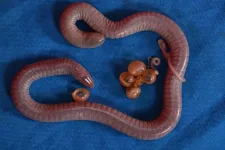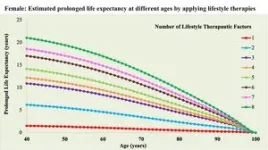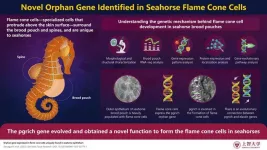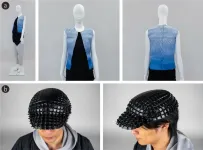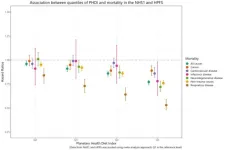(Press-News.org) Caecilians are an elusive type of amphibian that primarily live underground and look like a cross between a worm and a snake. One of the few things that is known about caecilians is their unique method for feeding their young. Mothers produce a special layer of fatty skin tissue, which juvenile caecilians tear off with baby teeth that evolved specifically for that purpose.
A new study shows that skin-feeding does more than provide nutrients for young caecilians. It also helps the mother pass microbes from her skin and gut down to her young, inoculating them to jump-start a healthy microbiome. This is the first direct evidence that parental care in an amphibian plays a role in passing microbes from one generation to the next.
“There's still a remarkable amount of caecilian biology that we just don't know anything about, mostly because they can be hard to find,” said David Blackburn, the Florida Museum’s curator of herpetology. “To our knowledge, this is the first published study of a caecilian microbiome.”
Across the animal kingdom, there are many different strategies for parental care. Human mothers give their babies breastmilk, emperor penguins regurgitate food for their chicks, and female koalas feed their young a special form of feces.
Among amphibians, caecilians are unique for feeding their young at all. Previous efforts to understand amphibian microbiomes focused on frogs and salamanders, the more well-known orders of the Amphibia class. Those studies, however, came back inconclusive largely because there are few frog and salamander species that care for their young after they’re born or hatched — most simply lay eggs and leave them to develop on their own.
Not so with caecilians.
“When you find the eggs, you always find the mother,” said Marcel Talla Kouete, first author of the study and a doctoral candidate in the University of Florida School of Natural Resources and Environment. “I've never seen a juvenile without an attending mother.”
Kouete said this is why he became fascinated by caecilians as he began working on them. Since this parenting behavior first came to light in 2006, scientists have noticed that even once skin-feeding ends, mother and babies stay together, with the former coiling her body around the latter. Kouete wondered whether the behavior served another function in addition to providing nutrients, reasoning that there was likely some transfer of the microbes from the surface of the mother’s skin, similar to bacterial transmission in other animals.
In humans, microbes move onto the skin as babies pass through the mother’s birth canal and into the body via breastmilk. These microbes help keep the human body alive and well, forming a microscopic community known as the microbiome, and perform essential tasks like breaking down complex carbohydrates, training the immune system and producing vitamins. A growing body of research seeks to better understand the relationship between disease and microbiome health.
Kouete and his colleagues focused their research on Herpele squalostoma, a caecilian species from central Africa that participates in skin-feeding behavior. They took samples from the environment as well as the skin and guts of 14 juveniles, nine female adults and six male adults. They then sequenced the bacteria colonies of each.
The researchers found that every juvenile shared some part of their skin and gut microbiome with their attending mother. This transfer happens both when the mother coils around the young, engaging in skin-to-skin contact, and when the juveniles eat the mother’s skin.
Samples taken from the surrounding soil, water and leaves showed that the immediate environment was the least important source for juvenile microbiomes.
In addition to shedding light on caecilian biology, Kouete’s paper contributes to the neglected research topic of African microbes. Despite the great genetic diversity on the African continent, microbiome research thus far has primarily focused on the Global North.
Until recently, caecilians have rarely been studied, in part, because they are native to the tropical regions of the Americas, Africa and Southeast Asia, where there has been a limited scientific presence. The H. squalostoma specimens used in the study were sampled in Cameroon, where Kouete is from.
For future investigation, the research team is curious about how microbiomes benefit caecilians and contribute to their health. “Is there an evolutionary advantage? If so, are these benefits absent when parental care is circumvented?” Kouete asked. This paper lays the groundwork for future studies by identifying some of the microbes present.
“This study is a bit like going out into the world and figuring out all the frogs that live in a forest,” Blackburn said. “We might find ground frogs, tree frogs and burrowing frogs; big species and small; ones that breed in this way or that way. Based on those characteristics, you could start inferring what role they play in the forest ecosystem, which is what we’d like to do with the caecilian microbiome.”
Molly Bletz, Brandon LaBumbard and Douglas Woodhams of the University of Massachusetts Boston are also authors on the paper.
END
Wormlike animals are first amphibians shown to pass microbes to their offspring
2023-07-24
ELSE PRESS RELEASES FROM THIS DATE:
Image-guided adaptive radiation treatments reduce short-term side effects for patients with prostate cancer
2023-07-24
A technique that uses imaging technology as a guide can make radiation therapy safer for patients with prostate cancer by helping clinicians accurately aim radiation beams at the prostate while avoiding nearby tissue in the bladder, urethra, and rectum. That is the finding of a thorough analysis of all published clinical trials of the technique, called magnetic resonance–guided daily adaptive stereotactic body radiotherapy (MRg-A-SBRT). The analysis is published by Wiley online in CANCER, a peer-reviewed journal of the American Cancer Society.
By providing detailed images, MRg-A-SBRT can be used to adjust a patient’s radiation plan every ...
Children and adolescents in food-insecure homes had more mental health visits
2023-07-24
Children and adolescents living in food-insecure households had a 55% higher frequency of physician visits for mental health reasons than those with adequate food supplies, according to new research published in CMAJ (Canadian Medical Association Journal) https://www.cmaj.ca/lookup/doi/10.1503/cmaj.230332.
In 2021, almost 6 million people Canada, including 1.4 million children and adolescents younger than 18 years faced food insecurity; that is, inadequate food intake because of financial problems.
The study looked at population health survey data from the Canadian Community Health Survey on ...
Gene conferring novel function to seahorse brood pouch identified
2023-07-24
Teleost fish encompass a diverse group, among which seahorses display a unique morphology. The characteristic spines and brood pouch seen in seahorses feature distinctive epithelial cells—called flame cone cells—covered by a mucous cap. However, these cells are not found in the barbed pipefish Urocampus nanus or the seaweed pipefish Syngnathus schlegeli, close relatives of the seahorse, belonging to the Syngnathidae lineage. While research has hypothesized the function of the flame cone cells, their evolutionary origins have remained a mystery.
Now, a team of scientists led by Assoc. Prof. Mari Kawaguchi and Prof. Shigeki Yasumasu from the Department of Materials ...
Two in three cosmetic surgery injections in the UK are not administered by doctors
2023-07-24
According to an analysis of the UK’s cosmetic injectables industry by UCL researchers, 68% of cosmetic practitioners who are administering injections such as Botox are not qualified medical doctors.
The study, published in the Journal of Plastic, Reconstructive & Aesthetic Surgery, is the first survey of who is providing cosmetic injectable services, such as Botulinum Toxin (Botox) and Dermal Fillers, in the UK. Currently, little is known about the background qualifications, training and experience levels of those who are administering treatments.
To fill this ...
A whole new dimension for 3D printing
2023-07-24
3D printing of complex objects typically takes a long time due to the printing process necessarily laying down a large number of 2D layers to build up the object. The process usually wastes a lot of material required to support the unfinished object. Some novel ways to make flat materials self-fold into 3D shapes exist, but have shortcomings. For the first time, researchers combined 2D printing, origami, and chemistry to create a method of rapid 3D object fabrication without creating any waste material. These shapes self-fold in seconds.
For some time, 3D printing has been used to prototype ...
MIND diet linked with better focus in school-aged children
2023-07-23
A diet originally designed to help ward off cognitive decline in adults might also help improve attention in pre-adolescents, according to a new study. The findings could help inform future dietary interventions aimed at improving cognition in children.
The new study examined two diets: the Healthy Eating Index – 2015 (HEI-2015), which is based on the Dietary Guidelines for Americans, and the Mediterranean-DASH Intervention for Neurodegenerative Delay (MIND) diet, which combines the Mediterranean diet with the heart-healthy Dietary Approaches to Stop Hypertension ...
These foods can help you live longer and protect the planet
2023-07-23
Eating more planet-friendly foods could help you live a longer, healthier life, according to new research. Researchers found that people who followed a more environmentally sustainable diet were 25% less likely to die during a follow-up period of over 30 years compared to those with a less sustainable diet.
The study builds upon prior research that identified foods that are a win-win for both health and the environment—such as whole grains, fruit, non-starchy vegetables, nuts, and unsaturated oils—as well as foods that could be harmful to the environment and human health, like eggs ...
Many children in rural areas receive high salt and sugar foods before age 2
2023-07-23
A study of over 10,000 children in rural Pennsylvania revealed that a large proportion of children were fed foods that are high in sugar and salt in their first years of life.
Over half (53%) of the children in the study received high-sodium meats such as hot dogs, 37% received salty snacks such as potato chips, and one-third (34%) received cakes, cookies, or pudding before age 2. In addition, over one-quarter (27%) of babies received juice before their first birthday.
“Given ...
The Lancet: People on ART with low but detectible levels of HIV viral load have almost zero risk of sexually transmitting the virus to others, in-depth review suggests
2023-07-23
Systematic review of 8 studies in more than 7,700 serodiscordant couples in 25 countries finds people living with HIV with viral loads less than 1,000 copies/mL have almost zero risk of transmitting the virus to their sexual partners. Previous studies have not been able to confirm a lack of transmission risk above 200 copies/mL.
Systematic review also consolidates and reinforces previous studies that have found there is zero risk of transmitting the virus to sexual partners when people living with HIV have an undetectable viral load.
Of the more than 320 documented sexual HIV transmissions ...
Researchers identify genes that directly influence what we eat
2023-07-22
In one of the first large-scale studies of genes related to diet, researchers have uncovered almost 500 genes that appear to directly influence the foods we eat. The findings represent an important step toward using a person’s genetics to develop precision nutrition strategies that help improve health or prevent disease.
“Some genes we identified are related to sensory pathways — including those for taste, smell, and texture — and may also increase the reward response in the brain,” said research team leader Joanne Cole, PhD, assistant professor in the Department ...
